This post may contain affiliate links.
This post may contain affiliate links, which means we may earn a small commission if you click them, but it does not change your price. Though this post is sponsored by Camping World, all opinions are my own.
This won’t be the most glamorous topic I’ve ever written about. Or even a difficult one. But I thought I’d share with you something that’s been a part of my personal RV winterization and storage routine for years. It’s easy enough to do. It’s inexpensive. And it can help you avoid problems with your RVs’ toilet.
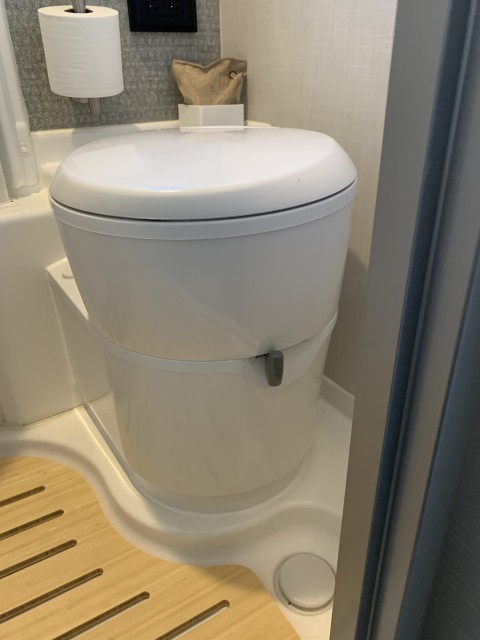
You see, here’s the deal with RV toilets – they rely on seals to keep odors out of the RV, and to keep water in the bowl. This is different from a home toilet, where you can count on a plug of water to keep odors out. In your RV, it’s just that rubber seal between you and a whole lot of bad smells. So it makes sense to keep that seal in the best condition possible.
In our current RV, we have a cassette toilet. But in a previous RV, we had a traditional RV toilet. Both of them have seals. In our previous RV, I had used a toilet seal lubricant as part of my winterization and storage routine. A quick check at Camping World showed that the Thetford Toilet Seal Lubricant and Conditioner was still available, and it was still getting consistently good reviews (which meant it hadn’t been reformulated into something less effective).
Even though we partner with Camping World and do projects with them frequently, I just go down to our local store to pick mine up. At about $10 for a bottle, this stuff is cheap insurance, and they always seem to have it in stock.
But I *don’t* use it according to the directions on the bottle. Here’s what I do:
Whenever I’m putting the RV away – either for the winter, or even just for a couple weeks during the season, I first go through the process to dump and rinse out the cassette. In our previous RV, I would drain and rinse out the black tank as well as possible.
Then I go through whatever other storage procedures I need to, depending on conditions. If I’m winterizing, this might include blowing out the water lines into the toilet.
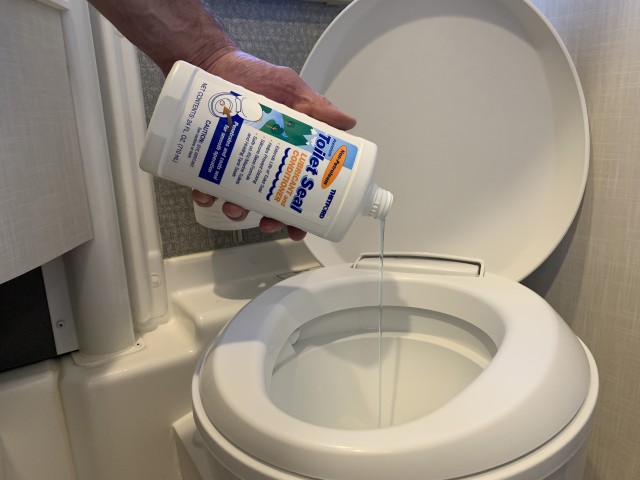
Finally, at the end of the process, I flush down any remaining water or antifreeze, and add just enough toilet seal conditioner to cover up the rubber seal. And that’s it! I put the rig away just like that. The Thetford lubricant and conditioner is safe to use even if I expect it might freeze. And in the literally years I’ve been doing this, I’ve never noticed any adverse effects from prolonged lubricant contact with the seals.
When it’s time to use the rig again, I just flush the conditioner down and start using the toilet. There’s no clean-up or re-activation required. One thing to note though, if you follow this process… if you have a cassette toilet like we do, make sure you flush the conditioner down BEFORE you remove the cassette for any reason. Otherwise, you’ll wind up with gooey blue silicone fluid in your cassette compartment.
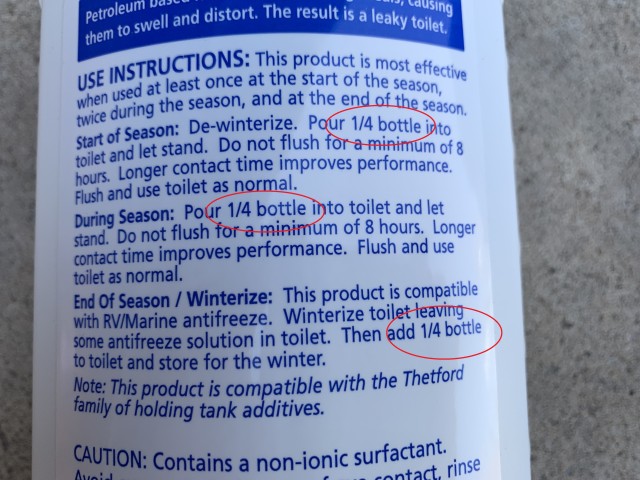
The directions on the bottle say to use a full ¼ of the bottle per application, but I find that’s wasteful. Anything more than just enough to cover the seals will only get flushed away. Those directions also say to use the product at the beginning, end, and twice during the season. But I’ve found that just adding a bit of the stuff whenever I’m putting the rig away takes care of that, and I don’t need to worry about remembering a maintenance schedule that way.
As I said, I’ve been using this stuff for years, and I’ve never had a toilet seal go bad. Maybe that’s just luck, but I’m giving some of the credit to this stuff. I know the job to replace a seal isn’t supposed to be that bad, but I’ve replaced RV toilets before, and… ick. I don’t want to mess around with them any more than I have to.
You can find Thetford Toilet Seal Lubricant and Conditioner anywhere RV products are sold, including at your local Camping World.
Cheers!

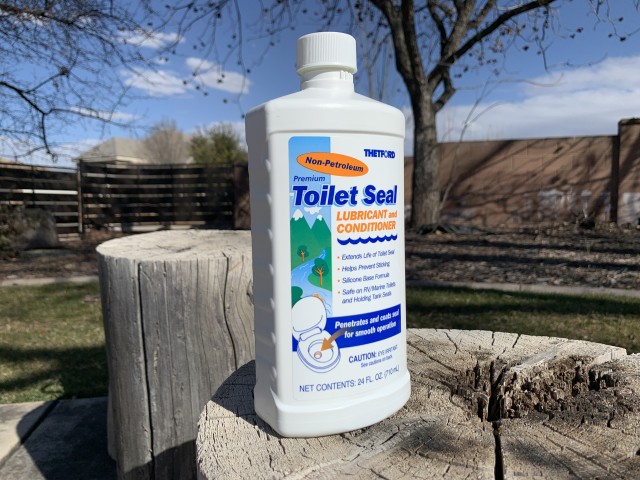



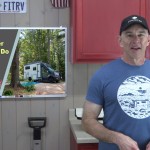
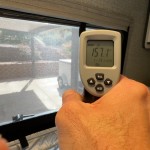





One thing that’s hard on the seal is the use of the Alcohol base RV antifreeze. It’s getting harder to find the non alcohol type which helps preserve the seal as well. I know I always pay more for it but is not so harsh on rubber parts.
Good point. Another reason why using the toilet seal conditioner makes sense.
And the good news is, if the seal does go bad or get a small knick in it while cleaning, it’s easy to replace. I’ve thought of carrying a spare seal with me, along with my spare dump hose gaskets, but the toilet works fine with a leaky seal, so I’ll just pick one up or order it if I ever need one. I do travel with extra lithium grease, since sometimes, if your seal is leaky, all you need to do is remove it, clean it, apply a thin coat of lithium grease, and reseat it. (You may have to fiddle with it to get it to seal.) Having said all that, I agree that conditioning the seal is important, especially when storing the vehicle or parking it unattended for a while.
Never tried the grease trick.
Personally, we have a cassette toilet. I don’t even know if the seals are replaceable on those, or if they just have you buy a new cassette.
Thanks for this advice, James — we’ll be sure to follow ir.
On a somewhat related topic, we’re also wondering what your assessment of the SOG is now that you’ve had a little time post-installation.
I’m still tinkering with it.
I’ll have a video out soon though. Before camping season really hits for sure.
Great, thanks!
James,
Do you have any opinion on the proposed fix for the recall on the Ekko bathroom drain problem? Love the RV but am wondering if the fix is a good one.
Kathy
I’ve reviewed the fix and I’m on board with it.
In my opinion, it even seems redundant. So I highly doubt a user with the fix would experience any leaks at all.
Can you tell me what the fix is?
There’s a new pump, new hoses and hose routing, and drip pans for redundancy.
If you want more information, you should join the “Winnebago EKKO Owners and Wannabes” group on Facebook.
You’ll find plenty of (maybe too much) discussion on there about the fix.
Never considered conditioning the seals. Great idea and will buy some at our next trip to Camping World. One last note, stopped by Lichtsinn and test drove an Ekko, in their store that had about 50 Americanizers. I was looking for the as designed by James from the FitRV, but never found it. Your creation is going mainstream!
Good information. Thank you James.
Thanks!